Tweaking Bread Recipes for Homemade Pizza
Any unsweetened, yeast bread dough can be used for pizza crust. The technique is the handling of the dough. So before I give you a few recipes, let’s talk about technique so that you can use your favourite recipe to make pizza, too.
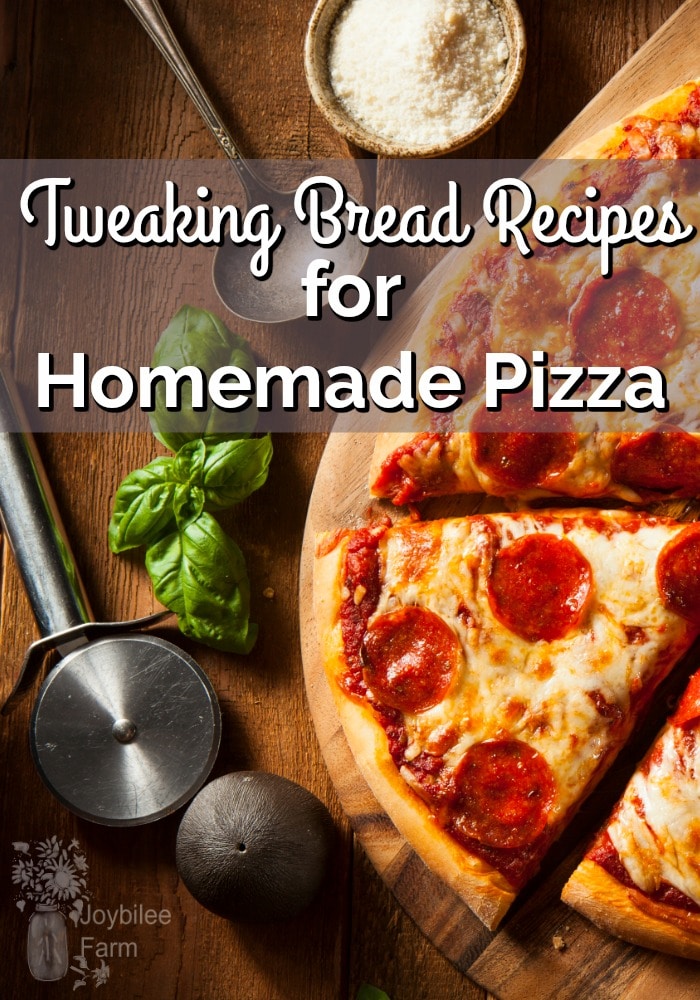
There are several kinds of pizza, but pizza is actually a peasant food designed to use up leftovers. It originates in Italy and different regions of Italy specialize in different types of pizza crust. Whether your family likes a thin, crispy crust, or a thick, chewy crust, or a deep pizza that’s almost a casserole – depends on what you are used to – your family’s culture.
So first let’s talk about the things that all pizzas have in common. With all pizza you are looking for a crisp bottom, you need a turned-up crust to hold the toppings in place, and you need cheese melted on top for that stringy, smooth, fatty mouth-feel that makes you crave pizza. (If you need a gluten-free recipe check out lesson 5.)
To achieve a crispy bottom, you want a high temperature for baking. It’s not unusual for a recipe to call for oven temperatures of 400F or even 450F. This is to master that crispy bottom crust. With high temperatures, you want to make sure that there is no sugar, molasses, or honey in the recipe. Sugar carmelizes at high temperatures and your crust will brown before it is baked if there is high sugar content in your dough. If you live at a higher elevation, turn down the heat, just a bit, and aim for the 400F oven. The water will escape from the dough at a lower temperature for you.
In addition to a high oven temperature, the pan that comes in contact with the pizza is often preheated in a professional kitchen. Pizza stones are made to be preheated and to have the pizza slid onto just before baking, using a bread paddle. Alternatively, a pizza pan with holes can be used to expose the bottom crust to direct heat – be sure to grease it well before laying the pizza dough onto the pan (voice of experience) or the dough will spread into the little holes making it impossible to separate your perfectly browned pizza from its pan. Special ovens are often used to bake the crust just right, using dry wood heat to crisp it to perfection.
Those backyard pizza ovens are designed to give you the perfect, crispy, thin pizza crust every time. They are preheated with a wood fire and the thick masonry walls, hold the heat evenly, to give you pizza perfection.
So what if you don’t have a pizza stone or a special pizza pan? What if you don’t have a pizza oven in your backyard? Then what? You can roll out your pizza on parchment paper or a board. Preheat a cast iron frying pan or dutch oven and slide your pizza, with parchment paper onto the preheated pan just before baking, for a crispy crust. Since your pan is going to cool down when you take it out of the oven and transfer your risen, and laden pizza onto it, preheat it to 450F and then turn the heat down to 400F when you put your pizza in. (use oven mitts to protect your hands and don’t get burned when you transfer the pizza to the pan)
I prefer to make my pizza in a pizza pan and avoid the heroics of getting a really crisp bottom crust. So it’s up to you how you achieve this or even if it’s important to you.
If you like a thinner edge crust, simply roll your pizza thinner to start with and fold the edge over just once. The crust will rise on the edges that you don’t cover with toppings, more than in the middle. You may need to get a feel for how thick to make the edge so that you don’t feel like you’ve got a loaf of bread on the edge of your pizza. Aim for just a single rolled edge to start and make it thinner or thicker as you practice until you get the results that your family prefers.
The more toppings you put on your pizza, the soggier the pizza will become. Don’t use very wet ingredients as pizza toppings – drain the pineapple, slice the cooked meat thinly, grate the cheese, use tomato powder or tomato paste rather than tomato sauce or salsa.
Pizza is a fun meal for a leisurely Friday or Saturday night when you aren’t too pressed for time. You can make the dough ahead and have the toppings prepared in bowls. You can let each family member make their own pizza just with toppings that they like. This helps with picky eaters and makes the meal a celebration time. Plan for at least 20 minutes baking time, and a 5 minute resting period, to solidify the cheese and toppings before serving the pizzas. That’s enough time to make a salad and homemade dressing to go with the meal. When I’m serving pizza like this, I make the individual pizza dough rounds and put them on a greased baking sheet – I can fit 4 pizzas on a baking sheet (don’t try this with gluten-free dough, it will spread and not hold together properly.)
Here is a traditional Pizza Dough recipe from Italy
(makes 2 thin 10 inch crusts)
Ingredients
1 ½ tsp. yeast
1 cup of warm water
2 tbsp. olive oil
½ tsp. salt
3 ½ cups of all-purpose flour (if the all-purpose flour in your region is soft wheat, use bread flour)
1 tbsp. cider vinegar (dough conditioner)
1 tbsp. warm water (optional if necessary, it will depend on your humidity.)
Method
Dissolve yeast in warm water. Allow the yeast to froth up. Mix yeast mixture, flour, olive oil, and salt. Beat well until the gluten starts to form strands. Then turn onto a floured counter and knead well, till smooth and elastic or process for 5 minutes with your stand mixer using the dough hook. You can also use your bread machine to mix this dough.
Cover the bowl and allow to rise until double in bulk, about 1 hour to 1 ½ hours.
Divide dough in half, and roll out thinly to the size of a 10-inch pizza pan.
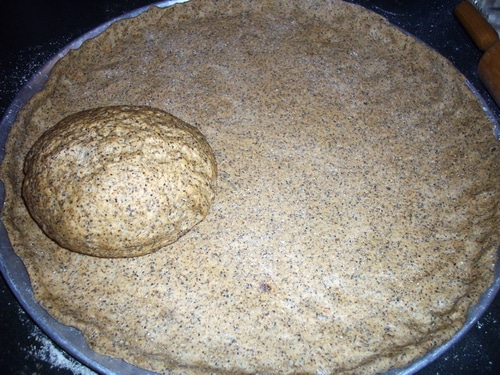
Now let’s look at this recipe and I’ll show you how to take the basic recipe and make it more interesting, by adding additional fibre and seeds and substituting textured flour for the all-purpose flour.
What needs to stay the same is the ratio of yeast, salt, flour, and liquid. But within that framework, you can play.
To this recipe, you can add up to 2 tbsp. of ground flax, chia seeds, or even shelled sunflower seeds, ground, or ground almonds. This will add both fibre, omega 3 fatty acids, and some oil. Lower the oil by 1 tbsp if you make this substitute.
You can substitute a whole grain flour for up to 1/3rd of the white flour – 1 to 1 ¼ cups. More than this and you will need to add more water, as whole-grain flours absorb more water than all-purpose white flour or unbleached white bread flour. If your dough seems dry, wet your hands when you knead rather than adding in more flour.
You can add non-glutinous flours if you add 1 tbsp of vital wheat gluten to compensate. Substitute no more than ½ a cup of nonglutinous flour as a substitute for ½ cup of bread flour.
You can add up to 1 tbsp of dried herbs to the crust for taste and interest sake or you can add up to 1 tbsp. of dried and powdered vegetables like tomato powder or carrot powder to give it interest and add more texture. Or you can combine dried herbs with dried vegetables – keeping the total addition to 1 tbsp. More than that and you will need to add more water. Note that 1 tbsp equals 3 tsp.
Print
Basic Pizza Crust
- Prep Time: 2 hours
- Cook Time: 40 minutes
- Total Time: 3 hours
- Yield: 1-2 pizza crusts 1x
Description
A basic, white, pizza crust
Ingredients
- 1 ½ tsp. yeast
- 1 cup of warm water
- 2 tbsp. olive oil
- ½ tsp. salt
- 3 ½ cups of all-purpose flour
- 1 tbsp. cider vinegar
- 1 tbsp. warm water
Instructions
- Dissolve yeast in warm water.
- Allow the yeast to froth up.
- Mix together yeast mixture, flour, olive oil, and salt.
- Beat well until the gluten starts to form strands.
- Turn onto floured counter and knead well, till smooth and elastic or process for 5 minutes with your stand mixer using the dough hook.
- Cover bowl and allow to rise until double in bulk, about 1 hour to 1 ½ hours.
- Divide dough in half, and roll out thinly to the size of a 10 inch pizza pan.
Some creative play:
That’s the basic principle of substitution that you can use with any yeast bread recipe to make the recipe truly your own. For this lesson, I’d like you to take the basic recipe and make it as written. And then create your own recipe using the principles I’ve given you here. Take a picture of both and post them on Facebook. If you don’t need to have pizza so often this week, just make the crust, bake it till just lightly brown, and freeze it – to add toppings later. Keep track of your creative recipe and post it on Facebook. We’ll add it to the cookbook at the end of the course.
Don’t be afraid to experiment. This is how you get comfortable.
Here’s my version of Multigrain Pizza Dough based on this recipe:
Ingredients:
1 ½ tsp. yeast
1 cup of warm water
½ tsp. Celtic sea salt, coarse
1 tbsp. coconut oil
1 tbsp. ground flax seed
1 tbsp. poppy seeds
½ c. freshly ground rye flour
½ c. buckwheat flour plus 1 tbsp. vital wheat gluten
2 ½ cups of unbleached bread flour
1 tsp. dried oregano
1 tsp. dried basil
1 tsp. tomato powder
1 tbsp. cider vinegar
1 tbsp. water (if necessary — it will depend on your humidity)
Method:
Dissolve yeast in warm water. Allow the yeast to froth up. Mix yeast mixture, rye flour, buckwheat flour, spices, tomato powder, bread flour, seeds, coconut oil, and salt. Beat well until the gluten starts to form strands. Then turn onto a floured counter and knead well, till smooth and elastic or process for 5 minutes with your stand mixer using the dough hook. You can also use your bread machine to mix this dough.
Cover the bowl and allow to rise until double in bulk, about 1 hour to 1 ½ hours.
Divide dough in half, and roll out thinly to the size of a 10-inch pizza pan.
Print
multi-grain pizza crust
- Prep Time: 2 hours
- Cook Time: 40 minutes
- Total Time: 3 hours
- Yield: 1 pizza crust 1x
Description
An example of a multi-grain pizza crust.
Ingredients
- 1 ½ tsp. yeast
- 1 cup of warm water
- ½ tsp. Celtic sea salt, coarse
- 1 tbsp. coconut oil
- 1 tbsp. ground flax seed
- 1 tbsp. poppy seeds
- ½ c. freshly ground rye flour
- ½ c. buckwheat flour plus 1 tbsp. vital wheat gluten
- 2 ½ cups of unbleached bread flour
- 1 tsp. dried oregano
- 1 tsp. dried basil
- 1 tsp. tomato powder
- 1 tbsp. cider vinegar
- 1 tbsp. water
Instructions
- Dissolve yeast in warm water.
- Allow the yeast to froth up.
- Mix together yeast mixture, rye flour, buckwheat flour, spices, tomato powder, bread flour, seeds, coconut oil, and salt.
- Beat well until the gluten starts of form strands.
- Turn onto floured counter and knead well, till smooth and elastic or process for 5 minutes with your stand mixer using the dough hook.
- Cover bowl and allow to rise until double in bulk, about 1 hour to 1 ½ hours.
- Divide dough in half, and roll out thinly to the size of a 10 inch pizza pan.
- Top with your desired pizza toppings and bake at 400 for 30-40 minutes or until pizza is done.
Note that buckwheat flour is gluten-free flour. Even though the word “wheat” is in the name, buckwheat is from an entirely different botanical family than wheat, rye, barley, and oats, which are grasses. Buckwheat gives a chewy texture to the bread.
Don’t stop with just a traditional pizza. There are many ways that you can form the crust for more excitement at your meals. Here’s just a few.
One alternative way to form the crust — Pizza Twist Bread
When you tire of pizza, here’s another way to form the crust. Pizza Twist bread can be done using any bread dough that you would use for pizza. The difference is not so much the recipe but how you handle the dough.
This will wow your friends and family!
Start by rolling out the pizza dough as you would if you were making pizza.
Spread tomato paste, spices, and top with cheese. You’ll want to go easy on the toppings or you won’t be able to roll the dough tightly enough.
Roll up as you would if you were making cinnamon buns — like making a jelly roll.
Instead of slicing the roll the normal way for cinnamon buns, slice lengthwise. Here are the directions that I wrote for my article on the Grainmill wagon:
Using a very sharp knife, cut the dough lengthwise, cleanly through. Take the two halves and twist them together, like a twisted rope, keeping the cut edge on the top of the twist. To make a wreath, overlap the two ends and moisten the dough at the overlap. Place on floured baking sheet. Brush with more melted herb-garlic butter. Cover with a towel to allow to rise. – See more at: The Grainmill Wagon
Bake this at 400F for 30 minutes. You’ll want the oven a little cooler than with a flat pizza so that the dough cooks all the way through before the crust is over brown, so bake it more as you would bake rolls rather than pizza.
Have fun with this lesson. I’d love to see what you come up with on the Facebook wall. See you there.


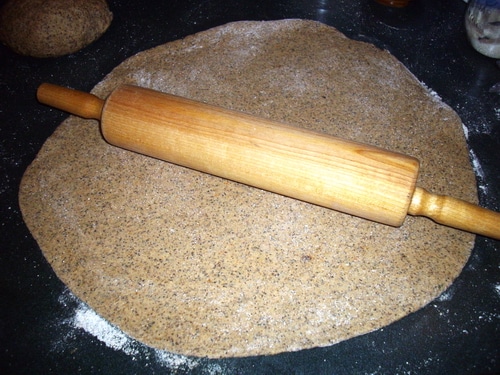
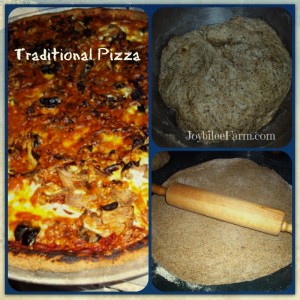

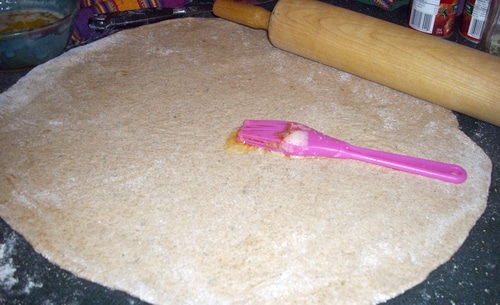

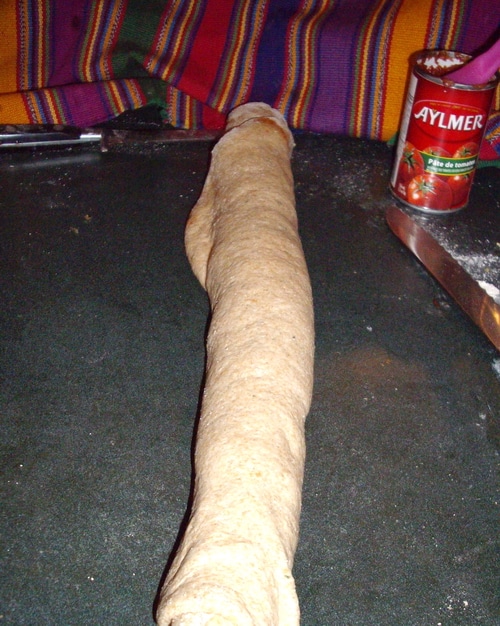
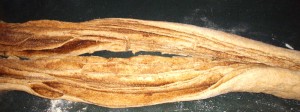


Leave a Reply